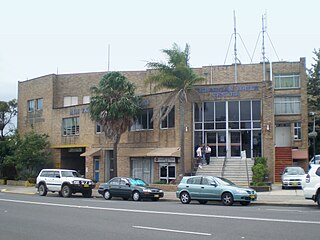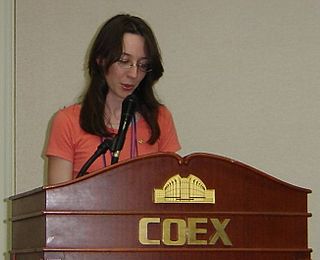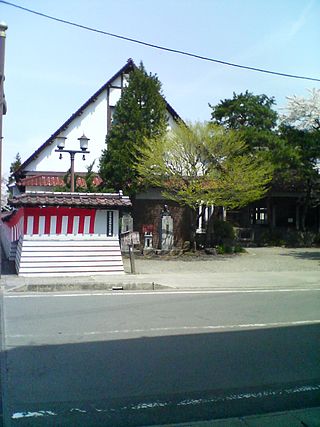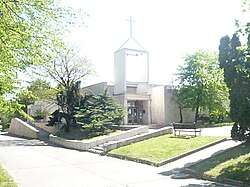
A public space is a place that is open and accessible to the general public. Roads, pavements, public squares, parks, and beaches are typically considered public space. To a limited extent, government buildings which are open to the public, such as public libraries, are public spaces, although they tend to have restricted areas and greater limits upon use. Although not considered public space, privately owned buildings or property visible from sidewalks and public thoroughfares may affect the public visual landscape, for example, by outdoor advertising. Recently, the concept of shared space has been advanced to enhance the experience of pedestrians in public space jointly used by automobiles and other vehicles.

A housing estate is a group of homes and other buildings built together as a single development. The exact form may vary from country to country.

In local government, a city hall, town hall, civic centre, guildhall, or municipal building is the chief administrative building of a city, town, or other municipality. It usually houses the city or town council, its associated departments, and their employees. It also usually functions as the base of the mayor of a city, town, borough, county or shire, and of the executive arm of the municipality.

Citizen participation or public participation in social science refers to different mechanisms for the public to express opinions—and ideally exert influence—regarding political, economic, management or other social decisions. Participatory decision-making can take place along any realm of human social activity, including economic, political, management, cultural or familial.

Youth work is a community support activity aimed at older children and adolescents. Depending upon the culture and the community, different services and institutions may exist for this purpose. In general, it provides an environment where young people can engage in informal educational activities. Throughout the United Kingdom, United States, and Canada, youth work is "to facilitate personal, educational, and social development." Through participative activities and coordinated programs, it seeks to enable young people in "gaining a voice, influence, and place in society in a period of their transition from dependence to independence." By nature and design these activities would be inclusive, educative, and empowering, and based on partnership, equality of opportunity, and respecting diversity.

A civic center or civic centre is a prominent land area within a community that is constructed to be its focal point or center. It usually contains one or more dominant public buildings, which may also include a government building. Recently, the term "civic center" has been used in reference to an entire central business district of a community or a major shopping center in the middle of a community. In this type of civic center, special attention is paid to the way public structures are grouped and landscaped.
The United Nations defines community development as "a process where community members come together to take collective action and generate solutions to common problems." It is a broad concept, applied to the practices of civic leaders, activists, involved citizens, and professionals to improve various aspects of communities, typically aiming to build stronger and more resilient local communities.

Community organizing is a process where people who live in proximity to each other or share some common problem come together into an organization that acts in their shared self-interest.

South Norwood is a district of south-east London, England, within the London Borough of Croydon, Greater London and formerly in the historic county of Surrey. It is located 7.8 miles (12.5 km) south-east of Charing Cross, north of Woodside and Addiscombe, east of Selhurst and Thornton Heath, south of Crystal Palace/Upper Norwood and Anerley, and south-west of Penge.

Maylands is a riverside inner-city suburb approximately 4.5 kilometres (2.8 mi) northeast of Perth centred on the Midland and High Wycombe railway lines on the northern bank of the Swan River.
A social enterprise is an organization that applies commercial strategies to maximize improvements in financial, social and environmental well-being. This may include maximizing social impact alongside profits for co-owners.

Palace of Culture or House of Culture is a common name for major club-houses in the former Soviet Union and the rest of the Eastern bloc.

The Bandra Kurla Complex is a business and residential district in the city of Mumbai, India. It is a prominent upscale commercial hub which commands some of the highest property rates in the country. According to MMRDA, the complex is the first of a series of "growth centres" created to "arrest further concentration" of offices and commercial activities in eastern parts of Mumbai. It has aided to decongest the CBD in South Mumbai while seeding new areas of planned commercial real estate in the metropolitan region.

Civic engagement or civic participation is any individual or group activity addressing issues of public concern. Civic engagement includes communities working together or individuals working alone in both political and non-political actions to protect public values or make a change in a community. The goal of civic engagement is to address public concerns and promote the quality of the community.

Citizen media is content produced by private citizens who are not professional journalists. Citizen journalism, participatory media and democratic media are related principles.
Democratic media is a form of media organization that strives to have the principles of democracy underlying not only the production of content, but also the organization of the entire project. Civic media is another term with similar concept and therefore can be used interchangeably in many contexts. The mission of the defunct Center for Civic Media of MIT is to design, create, deploy, and assess tools and processes that support and foster civic participation and the flow of information between and within communities, working at the intersection of participatory media and civic engagement.

Urban horticulture is the science and study of the growing plants in an urban environment. It focuses on the functional use of horticulture so as to maintain and improve the surrounding urban area. Urban horticulture has seen an increase in attention with the global trend of urbanization and works to study the harvest, aesthetic, architectural, recreational and psychological purposes and effects of plants in urban environments.
Myanmar has been under the rule of repressive authoritarian military regimes since 1962. After the 1974 Socialist constitution was suspended in 1988, constitutional protection of religious freedom has not existed, after the bloody suppression of the 8888 Uprising. The authorities generally permitted most adherents of registered religious groups to worship as they choose; however, the government imposed restrictions on certain religious activities and is accused of abusing the right to freedom of religion.

A kominkan, or citizens' public hall, is a kind of Japanese cultural center. Kominkan provide structured learning programs in arts, sport, handiwork and cultural activities, to children, youth and aged people. They are generally funded and administered by local governments.
Self-managed social centers, also known as autonomous social centers, are self-organized community centers in which anti-authoritarians put on voluntary activities. These autonomous spaces, often in multi-purpose venues affiliated with anarchism, can include bicycle workshops, infoshops, libraries, free schools, meeting spaces, free stores and concert venues. They often become political actors in their own right.





















